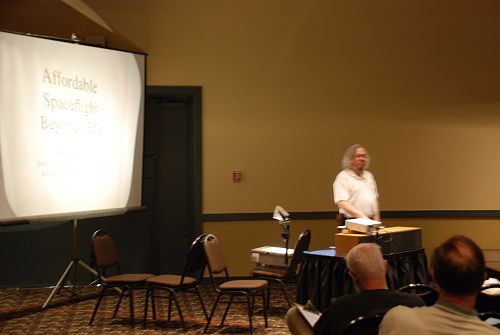|
Some themes in this year's Space Access Society meeting:
More groups are flying/building vehicles
- The success of the Masten Space team in the Northrop
Grumman Lunar Landing in 2009 announced their arrival
in the real live rocket vehicle club. Paul Breed did
not win a prize in the NG-LLC but people were nevertheless
impressed with the flying that was done by his small
team. These two groups join Armadillo Aerospace and
XCOR as regular members of the Space Access Society
who have now flown reusable, fast turnaround, rocket
powered vehicles in public forums.
Commonly heard word: "Aerodynamics"
- Everybody is going for higher altitudes now and that
means reducing drag to reduce fuel consumption during
the portion of the flight in the atmosphere. The VTVL
(Vertical Takeoff, Vertical Landing) guys like Armadillo
and Masten need to streamline their vehicles that were
flown in the NG-LLC if they are to get up to space (~100km)
and back down for a powered landing. The HTHL guy, XCOR,
has worked with aerodynamicists and carried out many
wind-tunnel studies to design their Lynx vehicle for
flying to 100km (initially to 60km with the interim
Mark I prototype).
A focus on challenges ahead -
With the success by Armadillo and Masten in the NG-LLC,
I was expecting a bit more of a triumphant and celebratory
atmosphere at the meeting. However, the focus primarily
was on future developments rather than past accomplishments.
Challenges like the aerodynamics issues mentioned above
must be overcome to achieve high altitudes reliably.
They seemed very sober and determined as they prepare
to tackle these challenges. The groups would very much
like to be reaching tens of kms if not 100 km by the
next meeting in 2011.
Suborbital science - Interest withn the
science community in flying experiments on the coming
reusable suborbital space vehicles, and, in particular,
doing human-tended experiments on the crew capable vehicles,
has grown substantially in the past year. There have
been several well-attended meetings on the subject,
there is interest by scientists in a broad range of
disciplines, NASA has decided to provide substantial
funding for such flights, and Alan Stern has been a
tireless proponent of the concept. Adding this market
to that of space tourism increases significantly the
robustness of the business plans of the companies building
these vehicles.
NASA going commercial - There were lots
of presentations plus lots of discussions outside the
conference hall about the big changes proposed for NASA
by the Obama Administration, especially the emphasis
on competitive commercial crew services for reaching
LEO. Many in the SAS have pushed for decades for NASA
to use the commercial services approach. The opposition
to it from within NASA and its political supporters
was not unexpected but there was optimism at the meeting
that this could be overcome with strong leadership by
the Administration, especially considering that the
Constellation is not viable within any likely budget.
A busy year ahead - The VTVL firms expect
to fly frequently in the coming year as they go for
100km. XCOR is starting construction of its first Lynx
rocketplane prototype and might be doing initial test
flights by the time of the next Space Access meeting.
The rocket vehicle companies could begin in the next
year to fly paid science payloads and generate income
even when flights have not yet reached 100km. Everyone
is anxiously waiting to see if the commercial initiatives
in the new NASA budget will be accepted by Congress.
|









